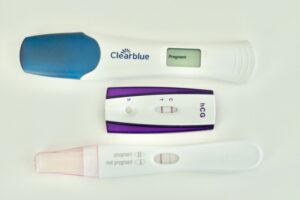
 Post Category - ParentingParenting - Post Category - BabyBaby
Post Category - ParentingParenting - Post Category - BabyBaby Post Category - Health & WellnessHealth & Wellness - Post Category - WellnessWellness
Post Category - Health & WellnessHealth & Wellness - Post Category - WellnessWellnessFood allergies 101
Whether you’re a new (first-time!) mama like myself, or parenting your third newborn, it’s likely you’ll be wondering what to feed your baby when he or she is ready for solids at six months. As your child is presented with a variety of new foods and gets accustomed to new tastes and textures, you’ll also start thinking (read: worrying!) about food allergies. This natural part of life is something that can cause kids a lot of discomfort, so it’s understandable that parents are looking to find out more. We’re here to answer some commonly asked questions, and put your mind at ease…
Common questions include:
1. Does my baby have any food allergies, and if he or she does, what types of food is he or she allergic to?
2. What can I do if I notice my baby develops a food-related allergic reaction?
Read more: Gluten-Free Dining: Celiac-Safe Restaurants and Cafés in Hong Kong

What is a food allergy?
Our immune system helps to guard the body against harmful substances. However, some individuals’ immune systems, mistakenly recognise particular types of food as harmful substances to the body. In order to protect the body, the immune system triggers a response to alert individuals to stop ingesting these foods. This response, which is physically presented as a symptom, can range from mild to severe – and it’s known as an allergic reaction. The number of symptoms and the severity of symptoms present can vary from one individual to another.
What is the difference between a food allergy and a food sensitivity?
A food allergy involves the immune system while a food sensitivity does not. For example, if an individual is lactose intolerant, he or she may be lacking in lactase, the digestive enzyme that breaks lactose, the milk sugar, into its building blocks, galactose and glucose. Undigested lactose gets passed to the large intestine where the bacteria in the gut feeds off the lactose, causing cramps and diarrhoea. A lactose sensitivity means you can still enjoy lactose-free dairy products! On the other hand, if the individual is allergic to milk, he or she is allergic to the milk protein, which means he or she cannot have dairy products, foods that contain dairy, and foods that are made in a facility where dairy is present.
Which foods cause allergic reactions?
The most common foods that cause allergic reactions are eggs, milk, fish, shellfish, nuts, peanuts, soy, wheat and sesame. Most of these common allergenic foods are protein-rich foods.
Read more: Quick, Easy and Healthy Dinner Recipes from Annabel Karmel

What are the common symptoms of food allergies?
As mentioned, an individual’s reaction to a food allergen can range from mild to severe, and the number of symptoms present can vary. Your baby may have an allergic reaction if he or she has hives or red rashes, itchy skin, swelling of the tongue, eyes, face, and lips, paleness or weakness, trouble breathing and swallowing, vomiting and diarrhea. While your baby may not experience all of these symptoms, the signs often appear within minutes after, or within two hours of having the allergenic food.
Is my child at risk of developing food allergies?
Your baby’s risk of developing food allergies is dependent on whether there is any immediate family member with food allergies. If one of the baby’s parents has food allergies, he or she will be at a higher risk to develop food allergies than a baby who does not have a family history of food allergies. In addition to food allergies, if there is a family history of asthma, eczema or hay fever, your baby is also at a higher risk to develop food allergies than one who does not.
What should I do if I suspect my baby has a food allergy? Does avoiding or delaying to feed my baby common allergenic foods prevent him or her from having food allergies?
When your baby starts eating solids at six months of age, he or she will be exposed to a wide range of foods. Avoiding or delaying common allergenic foods will not prevent him or her from having food allergies. This also applies to babies with a family history of food allergies.
If you are concerned about which foods may be causing a food allergy, you may want to introduce one common allergenic food at a time. Wait for at least two days before introducing a new food to your baby. You can also start a food journal to keep track of which foods you have given your baby so that you can know which foods your baby is potentially allergic to.
If you are breastfeeding and your child is at risk of food allergies, it is also unnecessary to avoid eating common allergenic foods. However, if you do choose to avoid certain foods, it may be best to speak with a registered dietitian to ensure you are meeting your nutritional needs.
What should I do if I suspect my child is having a food-related allergic reaction?
If you suspect your child is experiencing one or more symptoms, such as hives and red rashes, stop giving the food until you speak with your child’s pediatrician. The pediatrician may refer your child to see an allergist, who is a specialised doctor in providing treatments for individuals with allergies. The allergist may perform an allergy test on your child to clinically diagnose the condition. In addition, your child requires immediate medical attention if he or she experiences the following:
- Difficulty breathing
- Difficulty swallowing
- Spreading hives
- Swelling of the mouth, tongue and throat
- Paleness
- Lips or face turns blue
- Passing out
What should I be vigilant about if I have a child who has food allergies?
If your child has been clinically diagnosed with a specific type of food allergy, he or she may be advised by his or her healthcare provider or registered dietitian to avoid the food, and foods that contain the specific food allergen. Your registered dietitian may also advise you on various food alternatives to ensure your child is meeting his or her nutritional needs for adequate growth and development.
In addition to receiving professional advice, there are a number of things you can do to ensure your child does not experience an allergic reaction. For example, when you shop for groceries, read the ingredients’ list on food packaging to ensure the food does not have the allergen that your child is allergic to. It’s also vital to provide foods that are made in a facility that is free of the food allergen as the food allergen may contaminate foods during the manufacturing process. This information is typically communicated on the food packaging label where food manufacturers makes a statement that the food is made in an allergy-free facility, such as a nut-free facility. When eating out with your child, you may also want to notify your server that your child is allergic to a specific food and inquire about whether the menu item you wish to order is free of the food allergen.
All in all, allergies are something that many children all over the world live with – so the important thing is to make sure it’s managed in a way that makes your child feel safe and comfortable!
Read more: Third Pregnancy: The Decision to Go From 2 Kids to 3
 View All
View All











 View All
View All





 View All
View All


 View All
View All











